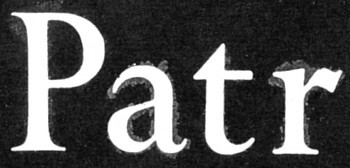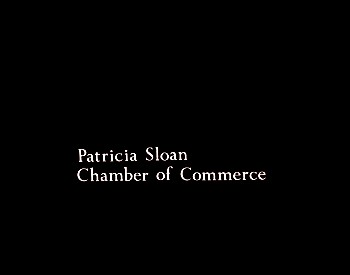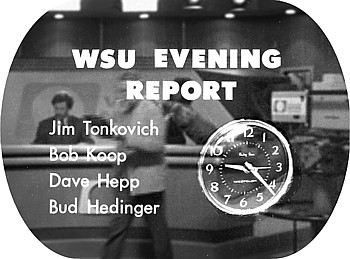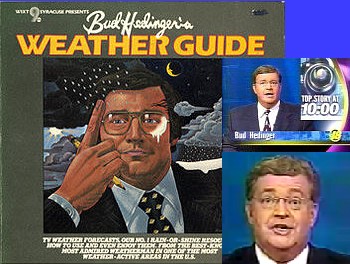TV
Show & Tell, 1970
Written
September 14, 2001
Additional
material December 29, 2008
I learned television in a master's degree program at Syracuse University in 1969-70.
Things were different then. The Newhouse TV studios had not yet been built, nor the present library. We had a small studio in the basement of the old library, equipped with black and white cameras.
In
those days, not every camera had a zoom lens. Many had turrets
which would rotate one fixed lens or another into position. To
make sure that your intended camera location and lens choice would
give you the correct field of view, you could experiment with the
actual camera. Lacking that, you could look through something like this cardboard
viewing gizmo.
Lacking that, you could look through something like this cardboard
viewing gizmo.
Cut from an 8" by 11" piece of cardboard, the gizmo's sides were intended to be folded toward you and the tabs inserted into the slots, forming an open-topped box 5" by 3" by 2". Then if you put your eye up to the small hole on the left, for example, you'd see through the larger hole on the opposite side of the box, labeled 90 mm. That would show you the field of view of a 90 mm TV camera lens.
To design this to the proper scale, I had to know arcane details such as the fact that a 50 mm lens has a 34° field of view and that the tangent of half that, or 17°, is .306.
|
Graphics
had not yet become electronic, so we used "transfer
lettering" alphabets that came on plastic sheets. |
|
|
We positioned each letter where we wanted it on an 11" by 14" piece of black poster board, then rubbed the plastic sheet to transfer the letter to the card.
The
cards were stacked on an easel and shot by one of the studio cameras. |
|
|
Above
right: a lower third used when Patty Sloan portrayed an
interview guest. Right: a title page for a fake newscast. I brought my alarm clock from home and fitted it into the round hole. |
|
|
The graphic was then keyed over a wide shot of our news set. It looked something like what you see here. (In this image, the clock and the studio are simulated. Our news desk was smaller.) |
|
|
The fourth man on our pretend news team, weatherman Bud Hedinger, soon was working with more sophisticated graphics. He was a real-life Syracuse meteorologist on channel 3 and later channel 9, whence this Weather Guide. |
|
Later Bud became a news anchor. He now hosts a talk radio show on 540 WFLA (actually WFLF) in Orlando.
As I recall, one of our live-to-tape student productions at public TV station WCNY was produced by Patty and directed by Bud. They decided to attempt a daring technical innovation: rolling in a segment that they'd recorded earlier at our on-campus studio with our newly acquired "quad" video tape machine. In the control room at WCNY, tension mounted as the time neared for the insert. Would the tape successfully lock into synchronization, or would the machine crash and leave the director with nothing to show? We held our breath as the assistant director counted down. Twenty seconds. Fifteen seconds. Ten seconds; roll the tape. Five seconds. Four. Three. We have speed. One. Take tape! The image from our on-campus studio appeared on the screen, and the control room erupted in cheers. There were hugs and cigars all around. No, not really, but someone did say "I feel like we just landed on the moon!"
(Click here for a sketch of my Apollo 13 re-entry graphics.)
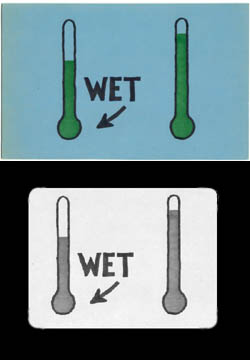 Artwork
for black and white television did not always have to be black and
white. For example, here is some blue and green artwork, a
7" by 11" graphics card from a short feature about
humidity, which is calculated from the difference between the
readings on thermometers with wet and dry bulbs. Below it is an
approximation of what this graphic would look like on black and white TV.
Artwork
for black and white television did not always have to be black and
white. For example, here is some blue and green artwork, a
7" by 11" graphics card from a short feature about
humidity, which is calculated from the difference between the
readings on thermometers with wet and dry bulbs. Below it is an
approximation of what this graphic would look like on black and white TV.
The card is drawn in Magic Marker on a piece of blue poster board — not white, because actual white was too "hot" for the cameras. The thermometers are filled in with green Magic Marker, an ugly color combination; but the viewer wouldn't see it in color, so it didn't matter. Green shows up as gray, which the viewer will probably interpret as red because it's a thermometer.
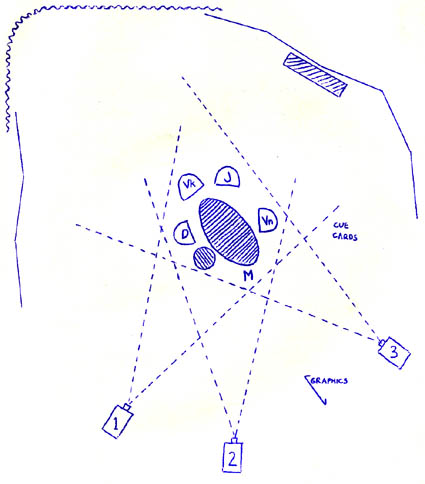
On March 11, 1970, I directed a TV show about the history of radio. It featured a scripted studio discussion with five people around a table.
As shown in the floor plan, each of my three cameras (using its wide 2-inch lens) could give me a "five-shot" covering the whole group of people. But with a tighter lens or a zoom lens, each camera could also shoot individuals or pairs or trios.
If I followed the usual procedure and said "Camera 1, give me a two-shot," I'd have to further specify which two people I wanted included in that shot.
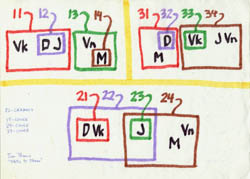 To
avoid confusion and wasted time, I drew up this chart for Cameras 1
(left), 2 (bottom), and 3 (right). When I merely said "Shot
12," Camera 1 could refer to his chart and know that I wanted
Don and John. Or if I said "Shot 13," he'd know to
give me Vin and Mike. Shots 19, 29, and 39 were five-shots.
To
avoid confusion and wasted time, I drew up this chart for Cameras 1
(left), 2 (bottom), and 3 (right). When I merely said "Shot
12," Camera 1 could refer to his chart and know that I wanted
Don and John. Or if I said "Shot 13," he'd know to
give me Vin and Mike. Shots 19, 29, and 39 were five-shots.
At one point in my notes, with Shots 22 and 32 already set up, I planned to say, "Ready 2, take 2." (We see Don, Vicki, and John.)
"Shot 19. Camera 2, ready a slow zoom in to Shot 23; start your zoom." (Now we see John alone.)
"Ready 1, take 1." (We see a re-establishing shot of all five people.)
"Ready 2, take 2." (Back to John.)
"Shot 14. Ready 1, take 1." (Mike.)
"Ready 3, take 3." (Don.)
"Shot 22. Ready 2, take 2." (Don, Vicki, and John.)
And so on. The method is a bit mechanical, but if it were used for the same show day after day, it would probably become second nature.
